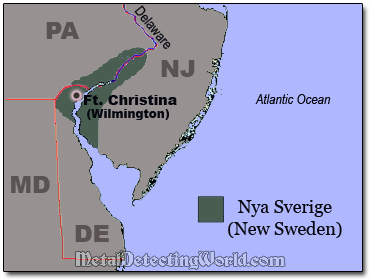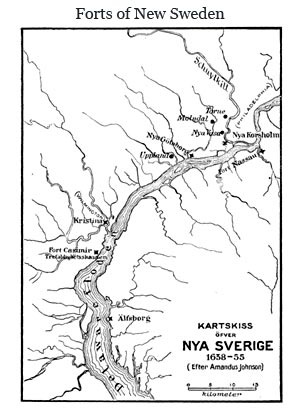Part I - Metal Detecting at the Swedish Tavern Site, page 17
Brief History of 'New Sweden' Colony in America
Surprisingly, the coins of this type have also been found on the American soil - at various locations along the Delaware River!
"New Sweden" - Brief Historical Facts:
By 1637, the Realm of Sweden, one of the great powers of Europe, had reached its largest territorial extent and now had a strong interest in North America. In late March of 1638, the first Swedish expedition anchored at a rocky point on the Minquas Kill that is known today as Swedes' Landing. The Swedes built a fort on the present site of the city of Wilmington, Delaware, which they named Fort Christina, after Queen Christina of Sweden.


Centered at Fort Christina, New Sweden (Swedish: Nya Sverige) - a tobacco growing and fur-trading colony, was created to bypass French and British merchants. The New Sweden colony included parts of the present-day American states of Delaware, New York, New Jersey, and Pennsylvania.
Along with Swedes and Finns, a number of the settlers were Dutch. Some Germans also came to the colony as soldiers in the Swedish army. In the following years, 600 people settled in the area.
The New Sweden colony expanded along the river from Fort Christina, establishing Fort Nya Elfsborg on the east bank of the Delaware near present-day Salem, New Jersey and Fort Nya Gothenborg on Tinicum Island (to the immediate Southwest of today's Philadelphia). The Swedish colony initially prospered.
In May 1654, the Dutch Fort Casimir was captured by soldiers from the New Sweden colony led by governor Johan Risingh. The fort was taken without a fight because its garrison had no gunpowder, and the fort was renamed Fort Trinity (in Swedish: Trefaldigheten).
As reprisal, the Dutch army moved to the Delaware River in the late summer of 1655, leading to the immediate surrender of Fort Trinity and Fort Christina. Thus the settlement was incorporated into Dutch New Netherlands on September 15, 1655. Sweden lost its colony, however, the Swedish and Finnish settlers continued to enjoy a degree of local autonomy, having their own militia, religion, court, and lands.
At the end of the Third Anglo-Dutch War, New Netherlands was captured by the British and assimilated together with the former area of New Sweden into the New York colony by the Treaty of Westminster of 1674. Traces of New Sweden persist in the Delaware Valley to this day, including Holy Trinity Church in Wilmington, Gloria Dei Church in Philadelphia, and Trinity Episcopal Church in Swedesboro, New Jersey, all commonly known as "Old Swedes' Churches". The log cabin, that the colonists brought with them, was the greatest contribution of New Sweden to the development of the New World, even though the log cabin has been always thought of as an American structure.
...A nice tiny bronze relic showed up next. First I thought it was a handle of the 17thth century ear-scoop, but the end point did not seem to be broken off. My next guess was that I found the winding key for a pocket watch. There was a small dog engraved on one side of a handle.
Many 18th century watch keys were miniature works of art being adorned with ornate designs, flowers, domestic animals, birds, shells, trees or portraits. This relic could be dated from the mid-18th to late 18th century.
Bronze Watch Key with Design, ca. 18th Century
